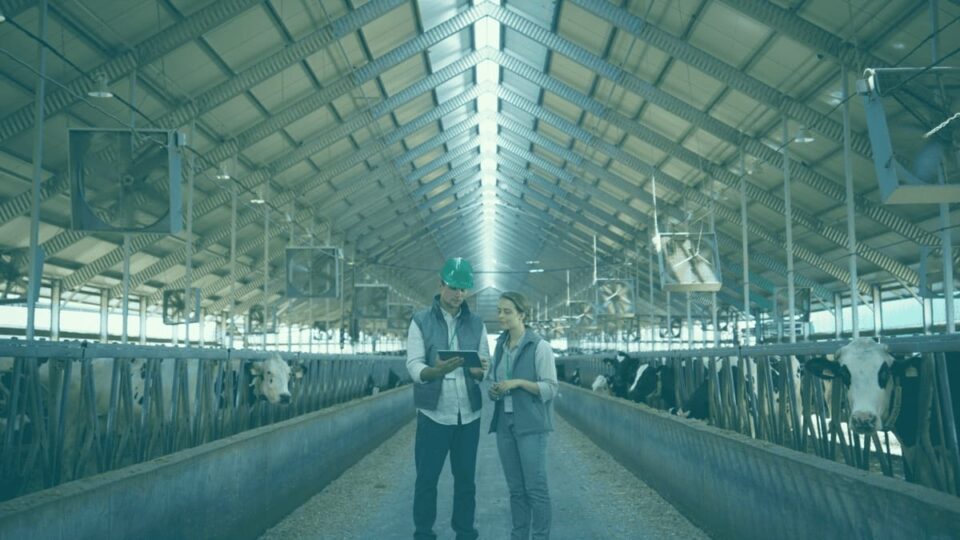Pneumonia is an inflammatory condition that affects the lungs, caused by bacteria, it can affect a range of livestock species including chickens and sheep. In fact, one study showed that approximately 50% of Australian sheep flocks are diagnosed with pneumonia. Pneumonia presents several issues for agricultural businesses during the winter, affecting efficiency and most importantly, animal welfare.
By preparing for the winter and investing in the necessary ventilation solutions, you can reduce the risk of pneumonia in your livestock.
Read on to learn about the effects of pneumonia in the agricultural industry during winter and the equipment you can use to reduce the prevalence of pneumonia in your livestock.
What are the consequences of livestock pneumonia in the agricultural industry?
When you do not address the problem of pneumonia in your agricultural facility, there can be consequences for operational efficiency, animal welfare, and finances. Here is a detailed breakdown of the effects of livestock pneumonia:
- Animal welfare – The symptoms of pneumonia in livestock include lung inflammation, difficulty breathing, coughing, lethargy, and even death. When animal welfare declines, you risk potential fatalities as well as reductions in the quality of produce.
- Operational efficiency – Reproduction performance, feed conversion rates, and growth rates are all key indicators that measure agricultural productivity and efficiency. If your livestock are suffering from pneumonia, you will notice a severe decline in these indicators.
- Economic consequences – Any outbreak within your agricultural facility will result in financial losses. To treat the epidemic, you must invest in veterinarian intervention and medications. The recovery period of each animal will also contribute to losses via decreased output.
What causes pneumonia in livestock and chicken coops?
Bacteria and infectious agents are the causes of pneumonia in livestock. For these agents to thrive, the environment must encourage bacteria growth. Here are some of the key contributors to pneumonia in barns and coops:
- Low environmental temperatures
- High humidity
- Poor ventilation
- Direct draughts
These environmental factors can compromise the immune system of your livestock. As this occurs, bacteria, viruses, and fungi compromise the lung health of your animals, leading to pneumonia.
Regulating a barn or coop’s temperature and humidity with agricultural ventilation can help mitigate these factors.
How to use barn ventilation to prevent pneumonia in livestock?
Understanding the severe consequences of pneumonia in your livestock and chicken coops reveals just why winter ventilation is so important. Let’s discuss the best barn ventilation solutions to keep your livestock healthy this winter.
Ventilation
Ventilating your space provides fresh air, improves air quality and reduces humidity. The top solutions to consider for agricultural ventilation include:
- Wall Plate Exhaust Fan – Extremely versatile and capable of high airflow, Wall Plate Exhaust Fans provide ventilation by removing stale air, dust, and odours from livestock facilities. They are typically fitted to barn walls and are ideal for confined spaces with high humidity levels.
- Portable Blower Extractor – If you require a portable solution, Fanquip’s lightweight, Portable Blower Extractors allow you to improve ventilation in livestock transport vehicles, coops, and barns. They provide targeted air circulation, even in confined spaces, reducing the potential spread of pathogens and providing cleaner air.
- Vertical Discharge Roof Fan – If your barn or coop structure cannot facilitate a Wall Plate Exhaust Fan, you can secure a Vertical Discharge Fan to the roof. This fan creates an upward airflow to extract air from the roof. This ventilation system is best suited to larger spaces, preventing the buildup of stale air and harmful gases while also providing temperature regulation.

Regulating temperature
Temperature regulation helps to promote immune system health for your livestock, reducing their risk of contracting pneumonia. If you require a solution that regulates the temperature of your barn or coop, consider one of the livestock ventilation options listed below.
- Heater Fan – For additional heat in farrowing rooms, wean-to-finish barns, and brooding poultry houses, Heater Fans contain heating elements with adjustable temperature features and automated shut-down mechanisms. Heater Fans provide comfort and reduce the potential for cold-induced respiratory stress in livestock.
- Air Circulator – Ideal for preventing stale air pockets and distributing temperature, an Air Circulator comes with adjustable fan speed and oscillation features. Air Circulators should be placed strategically throughout your livestock facility to prevent moisture buildup while ensuring consistent temperature for animal welfare.
- Giant Fan – Available in sizes ranging from 3,700mm to 7,300mm, Giant Fans are ideal for large-scale facilities such as chicken coops, dairy barns, and other high-ceiling animal holding sheds. The whisper quiet, high volume fans faciliate heat de-stratification in the winter – mixing the air within the building and reversing the natural process of thermal stratification wherby hot air rises.

How much ventilation does a livestock facility or chicken coop require in winter?
To ensure animal welfare, a chicken coop or barn should not exceed 75% humidity.
The average dairy cow will produce around 600 to 700 watts of heat, or 2000 to 2400 BTU/hr (British thermal unit), and breathe out around 22 litres of water in humidity per day. To determine how much ventilation you require for humidity and temperature control in winter, estimate the heat and moisture production based on the livestock capacity of your barn or chicken coop.
At Fanquip, we can help you determine your agricultural facility’s ventilation requirements based on capacity. By contacting our team today, you can receive advice from our ventilation experts.
Choose Fanquip for ventilation solutions – keep your livestock safe this winter
Ventilation is one of the critical components in preventing livestock pneumonia. Investing in ventilation and temperature control solutions can ensure your livestock’s immune health and reduce harmful pathogens in your barns and chicken coops.
At Fanquip, we provide clean air and quality ventilation equipment for various industries, including the agricultural sector. Contact us today to learn more about our ventilation equipment specifications.
